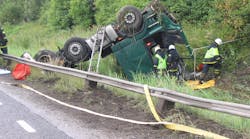In this guest column, Landon Biehl, an independent highway safety advocate based in Wilmington, NC, highlights some key factors in vehicle crashes involving trucks that many motorists may be unaware of. You can reach him on Twitter: @lbiehl1.
According to the U.S. Department of Labor, each year an estimated 475,000 large trucks are involved in accidents, with over 5,000 fatalities and over 140,000 injuries resulting from those accidents. While the statistics fluctuate each year, the number of fatal accidents involving a large truck continues to increase.
We know that certain factors such as distracted driving are common in many accidents, whether involving a large truck or a smaller vehicle, but there are contributing factors that are lesser known.
While truck drivers are far from perfect, they often have a bad reputation for being too aggressive behind the wheel or having bad judgment. Although some truck drivers are careless and aren’t devoted to safety, most truck drivers are responsible, as their livelihood and future depend on being a safe driver.
In about 70% of accidents involving large trucks, automobile drivers were to blame. While distracted driving and excessive speeds are some main factors, human errors and poor judgment (such as driving in blind spots) are also contributing factors.
In 2015, 29% of standard vehicle occupants killed in an accident involving a large truck were head-on crashes with the truck. This data suggests that drivers are either crossing the center line because of fatigue or distraction or are unsuccessful at passing a large truck.
Another 29% were involved in a crash that rear-ended a large truck; this suggests that drivers are tailgating and not prepared for the stopping time required for larger trucks.
Does this mean that commercial truck drivers are off the hook? Of course not, but motorists need to start to take a little accountability for their actions behind the wheel and learn how to share the road with big rigs.
For large truck drivers who have a standard Monday through Friday hauling and delivering schedule, Thursdays are the deadliest day on the road. Years of data suggest that Thursdays have consistently been the day with the most fatalities involving a truck driver; Fridays are a close second.
What is it about a Thursday that makes the day so deadly for truckers? Think about your own schedule. How do you feel on a Thursday, as your work week is coming to a close? When you’ve made more errors, was it after a restful weekend or near the end of the week?
It’s not fair to lump drivers into one group, but research shows that by Thursday, more truck drivers are physically and mentally exhausted, not to mention stressed out. Fatigued driving related accidents are more likely, and there’s a greater chance that a tired and stressed driver might overlook some important details or equipment checks.
One may assume that it’s more dangerous to share the road with a large truck at night or into the early morning hours due to drowsy truck drivers, but there are more fatal accidents between 6 a.m. and 3 p.m.
While these are the times of day when the roads are the busiest, it can also be assumed that drivers of all types of vehicles would be more alert (and able to avoid being in an accident). One might assume that the majority of accidents that happen during the daytime are related to human error and reckless driving behaviors.
The freeways and interstates always seem as though they would be the deadliest roads due to traffic congestion and the high volume of traffic but there are fewer fatalities involving a large truck than on major roads.
In 2015, 53% of deaths in accidents involving a large truck occurred on major roads (not interstates or freeways), while 30% of deaths occurred on interstates or freeways and 14% were on minor roads.
Why such a staggering different on major roads versus freeways? Speed is a contributing factor on major roads, where speed limits are higher. Excessive speed accounts for a little over 20% of fatal crashes.
While truck drivers and other motorists may be equally at fault for the fatal accidents that occur each year, increased awareness and teaching motorists of all types of vehicles how to share the road can decrease the number of preventable and fatal accidents.




